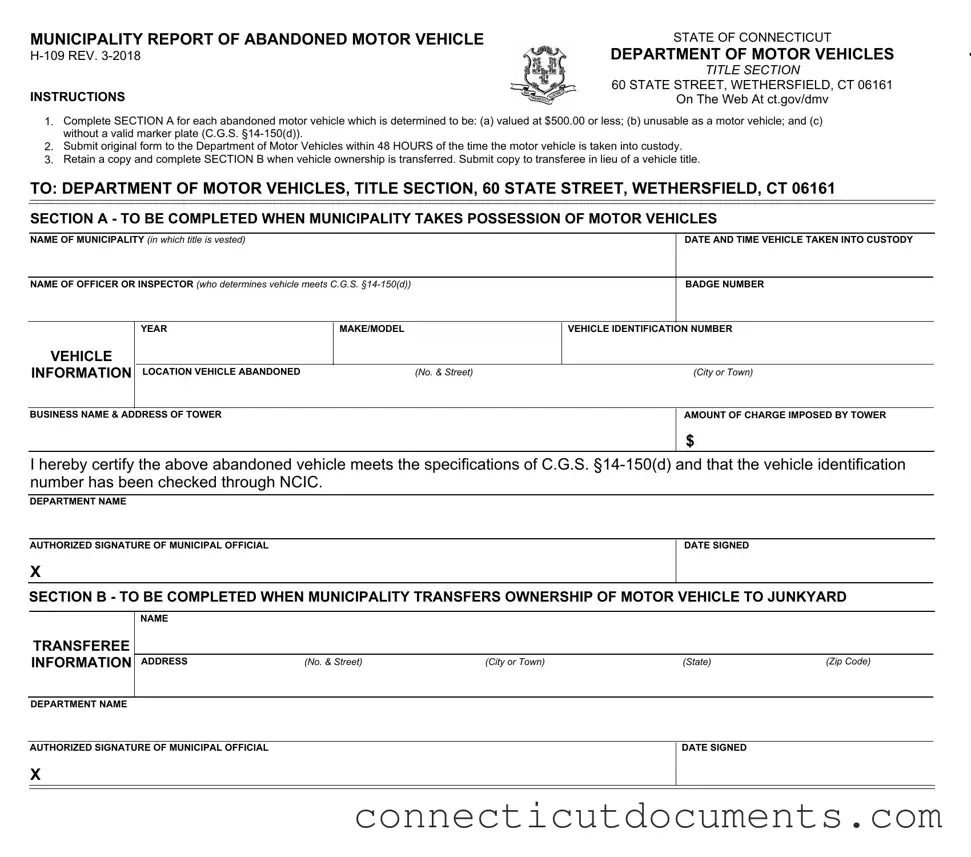The Connecticut H 109 form is similar to the Vehicle Title Application form. Both documents involve the transfer of ownership of a vehicle, but the Vehicle Title Application is used primarily for registering a vehicle with the Department of Motor Vehicles. While the H 109 focuses on abandoned vehicles, the Vehicle Title Application requires details about the new owner and the vehicle's history. Both forms ensure that the DMV has accurate records of vehicle ownership, but they serve different purposes within the vehicle registration process.
Another document comparable to the H 109 is the Abandoned Vehicle Report form used in many states. Like the H 109, this report is completed when a vehicle is deemed abandoned. It typically requires information about the vehicle's condition and location. However, the Abandoned Vehicle Report may not include specific sections for transferring ownership, which is a unique feature of the H 109. Both forms aim to facilitate the proper handling of abandoned vehicles, ensuring compliance with state laws.
The Salvage Title Application is another document that shares similarities with the H 109 form. Salvage titles are issued for vehicles that have been damaged or declared a total loss. While the H 109 deals with abandoned vehicles, the Salvage Title Application requires details about the vehicle’s damage and the insurance company’s involvement. Both forms help track the status of vehicles and ensure that the DMV maintains accurate records regarding their condition and ownership.
For landlords and property managers looking to streamline their tenant screening process, utilizing a standardized form such as the NY PDF Forms can significantly enhance efficiency and clarity in gathering essential information from prospective renters.
The Junked Vehicle Notification is also akin to the H 109. This document is used by municipalities to inform vehicle owners that their vehicle has been classified as junk. Similar to the H 109, it requires details about the vehicle and its condition. However, the Junked Vehicle Notification may not cover the transfer of ownership, which is a critical aspect of the H 109. Both documents are important for managing vehicles that are no longer operable or safe for use.
The Vehicle Impoundment Form is another document that bears resemblance to the H 109. This form is used when a vehicle is impounded by law enforcement. It collects information about the vehicle and the circumstances of its impoundment. While the H 109 focuses on abandoned vehicles, both forms require similar vehicle details and serve the purpose of documenting the status of vehicles that are no longer in regular use.
The DMV's Notice of Intent to Abandon form also parallels the H 109. This document is used to notify the DMV of a vehicle that the owner intends to abandon. Like the H 109, it gathers information about the vehicle, including its condition and location. However, the Notice of Intent to Abandon is initiated by the vehicle owner rather than a municipality. Both forms ensure that the DMV is informed about vehicles that are not in use, helping to manage abandoned vehicles effectively.
The Certificate of Destruction is another document that is similar to the H 109. This certificate is issued when a vehicle is permanently taken out of service and cannot be legally driven again. Like the H 109, it documents the vehicle's status and ensures that the DMV is aware of its condition. However, the Certificate of Destruction is used specifically for vehicles that are being scrapped, while the H 109 deals with abandoned vehicles that may still have some value.
Lastly, the Vehicle Registration Cancellation form can be compared to the H 109. This form is submitted when a vehicle owner decides to cancel their vehicle registration, often due to selling or abandoning the vehicle. While the H 109 focuses on abandoned vehicles taken into custody by municipalities, both forms help the DMV maintain accurate records regarding vehicle ownership and registration status. Each document plays a role in ensuring that the vehicle registration system remains up to date.
